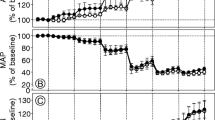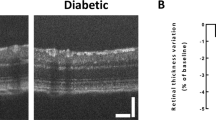Abstract
Adenosine is a potent vasodilator of retinal blood vessels and is implicated to be a major regulator of retinal blood flow during metabolic stress, but little is known about the impact of diabetes on the role of adenosine in regulation of retinal hemodynamics. Therefore, we examined how diabetes affects adenosine-induced vasodilation of retinal arterioles. Male Wistar rats were treated with streptozotocin (80 mg/kg, intraperitoneally), and experiments were performed 6–8 weeks later. Rats were treated with tetrodotoxin (50 μg/kg, intravenously [i.v.]) to eliminate any nerve activity and prevent movement of the eye and infused with methoxamine continuously to maintain adequate systemic circulation. Fundus images were captured with a digital camera that was equipped with a special objective lens, and diameters of retinal arterioles were measured. Adenosine increased diameters of retinal arterioles and decreased systemic blood pressure. These responses were significantly attenuated by the nitric oxide synthase inhibitor NG-nitro-l-arginine methyl ester (30 mg/kg, i.v.) and the adenosine triphosphate-dependent K+ (KATP) channel blocker glibenclamide (20 mg/kg, i.v.). The depressor responses to adenosine were reduced in diabetic rats, whereas diabetes did not alter vasodilation of retinal arterioles to adenosine. In contrast, both depressor response and vasodilation of retinal arteriole to acetylcholine were reduced in diabetic rats. The retinal vasodilator responses to adenosine and acetylcholine observed in diabetic rats were diminished by NG-nitro-l-arginine methyl ester. There were no differences in the responses to pinacidil, a KATP channel opener, between the diabetic and nondiabetic rats. These results suggest that both the activation of nitric oxide synthase and opening of KATP channels contribute to the vasodilator effects of adenosine in rats in vivo. However, diabetes has no significant impact on the vasodilation mediated by these mechanisms in the retinal circulation.




Similar content being viewed by others
References
Benedito S, Prieto D, Nielsen PJ, Nyborg NC (1991) Role of the endothelium in acetylcholine-induced relaxation and spontaneous tone of bovine isolated retinal small arteries. Exp Eye Res 52:575–579
Boussery K, Delaey C, Van de Voorde J (2002) Rat retinal tissue releases a vasorelaxing factor. Invest Ophthalmol Vis Sci 43:3279–3286
Braunagel SC, Xiao JG, Chiou GC (1988) The potential role of adenosine in regulating blood flow in the eye. J Ocul Pharmacol 4:61–73
Bryan PT, Marshall JM (1999) Cellular mechanisms by which adenosine induces vasodilatation in rat skeletal muscle: significance for systemic hypoxia. J Physiol 514:163–175
Cabell F, Weiss DS, Price JM (1994) Inhibition of adenosine-induced coronary vasodilation by block of large-conductance Ca2+-activated K+ channels. Am J Physiol 267:H1455–H1460
Campochiaro PA, Sen HA (1989) Adenosine and its agonists cause retinal vasodilation and hemorrhages. Implications for ischemic retinopathies. Arch Ophthalmol 107:412–416
Cavero I, Mondot S, Mestre M (1989) Vasorelaxant effects of cromakalim in rats are mediated by glibenclamide-sensitive potassium channels. J Pharmacol Exp Ther 248:1261–1268
Danialou G, Vicaut E, Sambe A, Aubier M, Boczkowski J (1997) Predominant role of A1 adenosine receptors in mediating adenosine induced vasodilatation of rat diaphragmatic arterioles: involvement of nitric oxide and the ATP-dependent K+ channels. Br J Pharmacol 121:1355–1363
De La Cruz JP, Gonzalez-Correa JA, Guerrero A, de la Cuesta FS (2004) Pharmacological approach to diabetic retinopathy. Diabetes Metab Res Rev 20:91–113
De Vriese AS, Verbeuren TJ, Van de Voorde J, Lameire NH, Vanhoutte PM (2000) Endothelial dysfunction in diabetes. Br J Pharmacol 130:963–974
Delaey C, Van de Voorde J (1998) Retinal arterial tone is controlled by a retinal-derived relaxing factor. Circ Res 83:714–720
Dumskyj MJ, Kohner EM (1999) Retinal blood flow regulation in diabetes mellitus: impaired autoregulation and No detectable effect of autonomic neuropathy using laser Doppler velocimetry, computer assisted image analysis, and isometric exercise. Microvasc Res 57:353–356
Feke GT, Buzney SM, Ogasawara H, Fujio N, Goger DG, Spack NP, Gabbay KH (1994) Retinal circulatory abnormalities in type 1 diabetes. Invest Ophthalmol Vis Sci 35:2968–2975
Frederiksen CA, Jeppesen P, Knudsen ST, Poulsen PL, Mogensen CE, Bek T (2006) The blood pressure-induced diameter response of retinal arterioles decreases with increasing diabetic maculopathy. Graefe Arch Clin Exp Ophthalmol 244:1255–1261
Gardiner SM, Kemp PA, Bennett T (1991) Effects of NG-nitro-L-arginine methyl ester on vasodilator responses to acetylcholine, 5′-N-ethylcarboxamidoadenosine or salbutamol in conscious rats. Br J Pharmacol 103:1725–1732
Ghirlanda G, Di Leo MA, Caputo S, Cercone S, Greco AV (1997) From functional to microvascular abnormalities in early diabetic retinopathy. Diabetes Metab Rev 13:15–35
Gidday JM, Park TS (1993a) Microcirculatory responses to adenosine in the newborn pig retina. Pediatr Res 33:620–627
Gidday JM, Park TS (1993b) Adenosine-mediated autoregulation of retinal arteriolar tone in the piglet. Invest Ophthalmol Vis Sci 34:2713–2719
Gidday JM, Maceren RG, Shah AR, Meier JA, Zhu Y (1996) KATP channels mediate adenosine-induced hyperemia in retina. Invest Ophthalmol Vis Sci 37:2624–2633
Haefliger IO, Flammer J, Luscher TF (1992) Nitric oxide and endothelin-1 are important regulators of human ophthalmic artery. Invest Ophthalmol Vis Sci 33:2340–2343
Hein TW, Belardinelli L, Kuo L (1999) Adenosine A2A receptors mediate coronary microvascular dilation to adenosine: role of nitric oxide and ATP-sensitive potassium channels. J Pharmacol Exp Ther 291:655–664
Hein TW, Yuan Z, Rosa RH Jr, Kuo L (2005) Requisite roles of A2A receptors, nitric oxide, and KATP channels in retinal arteriolar dilation in response to adenosine. Invest Ophthalmol Vis Sci 46:2113–2119
Jeppesen P, Aalkjaer C, Bek T (2002) Adenosine relaxation in small retinal arterioles requires functional Na-K pumps and KATP channels. Curr Eye Res 25:23–28
Kaneko Y, Saito M, Mori A, Sakamoto K, Nakahara T, Ishii K (2006) Vasodilator effects of adrenomedullin on retinal arterioles in streptozotocin-induced diabetic rats. J Ocular Pharmacol Ther 22:317–322
Mubagwa K, Flameng W (2001) Adenosine, adenosine receptors and myocardial protection: an updated overview. Cardiovasc Res 52:25–39
Nakazawa T, Kaneko Y, Mori A, Saito M, Sakamoto K, Nakahara T, Ishii K (2007) Attenuation of nitric oxide- and prostaglandin-independent vasodilation of retinal arterioles induced by acetylcholine in streptozotocin-treated rats. Vascular Pharmacol 46:153–159
Ogawa N, Saito M, Mori A, Sakamoto K, Kametaka S, Nakahara T, Ishii K (2007) Vasodilator effect of nicorandil on retinal blood vessels in rats. Naunyn-Schmiedeberg’s Arch Pharmacol 375:323–328
Oyama Y, Kawasaki H, Hattori Y, Kanno M (1986) Attenuation of endothelium-dependent relaxation in aorta from diabetic rats. Eur J Pharmacol 132:75–78
Polska E, Ehrlich P, Luksch A, Fuchsjager-Mayrl G, Schmetterer L (2003) Effects of adenosine on intraocular pressure, optic nerve head blood flow, and choroidal blood flow in healthy humans. Invest Ophthalmol Vis Sci 44:3110–3114
Riva CE, Sinclair SH, Grunwald JE (1981) Autoregulation of retinal circulation in response to decrease of perfusion pressure. Invest Ophthalmol Vis Sci 21:34–38
Robinson F, Riva CE, Grunwald JE, Petrig BL, Sinclair SH (1986) Retinal blood flow autoregulation in response to an acute increase in blood pressure. Invest Ophthalmol Vis Sci 27:722–726
Sinclair SH, Grunwald JE, Riva CE, Braunstein SN, Nichols CW, Schwartz SS (1982) Retinal vascular autoregulation in diabetes mellitus. Ophthalmology 89:748–750
Stella L, Berrino L, Filippelli A, de Novellis V, Rossi F (1995) Nitric oxide participates in the hypotensive effect induced by adenosine A2 subtype receptor stimulation. J Cardiovasc Pharmacol 25:1001–1005
Tabrizchi R, Bedi S (2001) Pharmacology of adenosine receptors in the vasculature. Pharmacol Ther 91:133–147
Taylor PD, McCarthy AL, Thomas CR, Poston L (1992) Endothelium-dependent relaxation and noradrenaline sensitivity in mesenteric resistance arteries of streptozotocin-induced diabetic rats. Br J Pharmacol 107:393–399
Acknowledgements
This study was supported in part by Grant-in Aid for Scientific Research from the Ministry of Education, Culture, Sports, Science and Technology, Japan and by the Uehara Memorial Foundation.
Author information
Authors and Affiliations
Corresponding author
Rights and permissions
About this article
Cite this article
Nakazawa, T., Mori, A., Saito, M. et al. Vasodilator effects of adenosine on retinal arterioles in streptozotocin-induced diabetic rats. Naunyn-Schmied Arch Pharmacol 376, 423–430 (2008). https://doi.org/10.1007/s00210-007-0233-z
Received:
Accepted:
Published:
Issue Date:
DOI: https://doi.org/10.1007/s00210-007-0233-z




